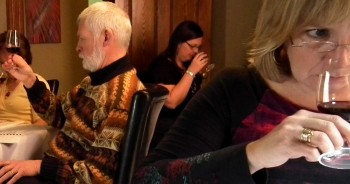 “Now ladies and gentlemen, if you will each raise your wine glass to your nose I’m sure that you will agree that the scent of black cherry, cinnamon, truffle and the slightest hint of wet stone quite typically displays the varietal character of this wine.”
“Now ladies and gentlemen, if you will each raise your wine glass to your nose I’m sure that you will agree that the scent of black cherry, cinnamon, truffle and the slightest hint of wet stone quite typically displays the varietal character of this wine.”
What the hell! Am I the only person in the room that has a problem with this? Judging by the expression on the lady’s face sitting across from me, apparently not – in fact, I think the cork just flew over her head.
“Is it wrong that all I smell is red wine?” she whispered.
“Do you like it?” I queried back.
“Ya, it tastes really good but I don’t smell any of those things.”
With one eyebrow raised, I responded “I doubt that he does either”.
That was a few months ago at a fancy dinner hosted by a gentleman who’s tie was just a little too tight as he attempted to educate the group on the wines being served while reading from his cue-cards. Ridiculous – yes, but it does bring up a good discussion.
Don’t get me wrong, I’m all about enjoying the fine nuances of a great glass of wine but please don’t make more of this than need be; it’s a drink, not a science project, and there is both a time and place where this sort of critique is valid, but that place is not at the dinner table surrounded by people who really don’t care to know this information.
So the question remains: Can anyone actually smell or taste the bizarre array of adjectives regularly printed on tasting note cards alongside bottles on the store shelves? The short answer is ‘yes’ while the abbreviated and slightly sarcastic long answer is ‘who really cares’, but more so, what do you stand to gain from these tasting notes?
The author of any tasting note is describing the variety of grape(s) and style of wine. Within that style, he or she may also find a curious scent or taste to complement the typical (varietal) character of the wine in question.
Shiraz for example will normally display a rather pronounced aroma and taste of dark fruits such blackberries and plums in addition to the sensation of dark chocolate and pepper spice. If the wine is from a warm new world region such as Australia, these characteristics tend to be more obvious than the same from a traditional producer in the cooler climates of France.
Does that mean that you are wrong to detect something else, like raspberries or leather? Not at all, and that is what makes this subject so interesting. Wine is subjective; your mood, the theme of the restaurant, food pairing choices, and the company you share will all influence the taste of a glass of wine.
Tyler is the founder of North of 9 Fine Wine and also writes about wine in Footprints Magazine.
 Together with his collection of wine aficionados, the North of 9 Tasting Group gather once per month to sample and discuss wine from around the world. He endeavours to promote and educate those who enjoy a really good glass of wine through his non-biased tastings.
Together with his collection of wine aficionados, the North of 9 Tasting Group gather once per month to sample and discuss wine from around the world. He endeavours to promote and educate those who enjoy a really good glass of wine through his non-biased tastings.
Note from Tyler: Rarely do I publish a review of a wine that I did not enjoy. My taste is purely individual, as is your own. If I write about a particular wine, I do so because I also want you to try it.








LOL! Finally, someone that says what I feel. Why must it always be so complicated?
This is great Natalie!
Thank you
Glad you liked this Stewart! Tyler did a great job on it :)
Thanks for the comment Stewart. Together you, me, Natalie, and an army of wine enthusiasts everywhere will put an end to snobbery and pretension. Walk softly and carry a big corkscrew Mate.
Cheers!